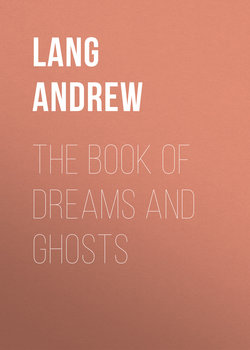Читать книгу The Book of Dreams and Ghosts - Lang Andrew, May Kendall - Страница 28
CHAPTER III
STORY OF THE DIPLOMATIST 28
ОглавлениеFor example, there is a living diplomatist who knows men and cities, and has, moreover, a fine sense of humour. “My Lord,” said a famous Russian statesman to him, “you have all the qualities of a diplomatist, but you cannot control your smile.” This gentleman, walking alone in a certain cloister at Cambridge, met a casual acquaintance, a well-known London clergyman, and was just about shaking hands with him, when the clergyman vanished. Nothing in particular happened to either of them; the clergyman was not in the seer’s mind at the moment.
This is a good example of a solitary hallucination in the experience of a very cool-headed observer. The causes of such experiences are still a mystery to science. Even people who believe in “mental telegraphy,” say when a distant person, at death or in any other crisis, impresses himself as present on the senses of a friend, cannot account for an experience like that of the diplomatist, an experience not very uncommon, and little noticed except when it happens to coincide with some remarkable event. 29 Nor are such hallucinations of an origin easily detected, like those of delirium, insanity, intoxication, grief, anxiety, or remorse. We can only suppose that a past impression of the aspect of a friend is recalled by some association of ideas so vividly that (though we are not consciously thinking of him) we conceive the friend to be actually present in the body when he is absent.
These hallucinations are casual and unsought. But between these and the dreams of sleep there is a kind of waking hallucinations which some people can purposely evoke. Such are the visions of crystal gazing.
Among the superstitions of almost all ages and countries is the belief that “spirits” will show themselves, usually after magical ceremonies, to certain persons, commonly children, who stare into a crystal ball, a cup, a mirror, a blob of ink (in Egypt and India), a drop of blood (among the Maoris of New Zealand), a bowl of water (Red Indian), a pond (Roman and African), water in a glass bowl (in Fez), or almost any polished surface. The magical ceremonies, which have probably nothing to do with the matter, have succeeded in making this old and nearly universal belief seem a mere fantastic superstition. But occasionally a person not superstitious has recorded this experience. Thus George Sand in her Histoire de ma Vie mentions that, as a little girl, she used to see wonderful moving landscapes in the polished back of a screen. These were so vivid that she thought they must be visible to others.
Recent experiments have proved that an unexpected number of people have this faculty. Gazing into a ball of crystal or glass, a crystal or other smooth ring stone, such as a sapphire or ruby, or even into a common ink-pot, they will see visions very brilliant. These are often mere reminiscences of faces or places, occasionally of faces or places sunk deep below the ordinary memory. Still more frequently they represent fantastic landscapes and romantic scenes, as in an historical novel, with people in odd costumes coming, going and acting. Thus I have been present when a lady saw in a glass ball a man in white Oriental costume kneeling beside a leaping fountain of fire. Presently a hand appeared pointing downwards through the flame. The first vision seen pretty often represents an invalid in bed. Printed words are occasionally read in the glass, as also happens in the visions beheld with shut eyes before sleeping.
All these kinds of things, in fact, are common in our visions between sleeping and waking (illusions hypnagogiques). The singularity is that they are seen by people wide awake in glass balls and so forth. Usually the seer is a person whose ordinary “mental imagery” is particularly vivid. But every “visualiser” is not a crystal seer. A novelist of my acquaintance can “visualise” so well that, having forgotten an address and lost the letter on which it was written, he called up a mental picture of the letter, and so discovered the address. But this very popular writer can see no visions in a crystal ball. Another very popular novelist can see them; little dramas are acted out in the ball for his edification. 30
These things are as unfamiliar to men of science as Mr. Galton found ordinary mental imagery, pictures in memory, to be. Psychology may or may not include them in her province; they may or may not come to be studied as ordinary dreams are studied. But, like dreams, these crystal visions enter the domain of the ghostly only when they are veracious, and contribute information previously unknown as to past, present or future. There are plenty of stories to this effect. To begin with an easy, or comparatively easy, exercise in belief.
29
The author knows some eight cases among his friends of a solitary meaningless hallucination like this.
30
As to the fact of such visions, I have so often seen crystal gazing, and heard the pictures described by persons whose word I could not doubt, men and women of unblemished character, free from superstition, that I am obliged to believe in the fact as a real though hallucinatory experience. Mr. Clodd attributes it to disorder of the liver. If no more were needed I could “scry” famously!
